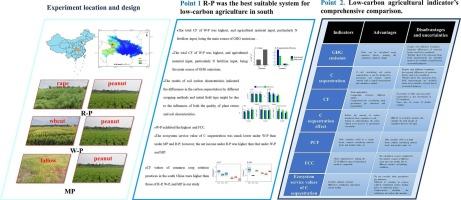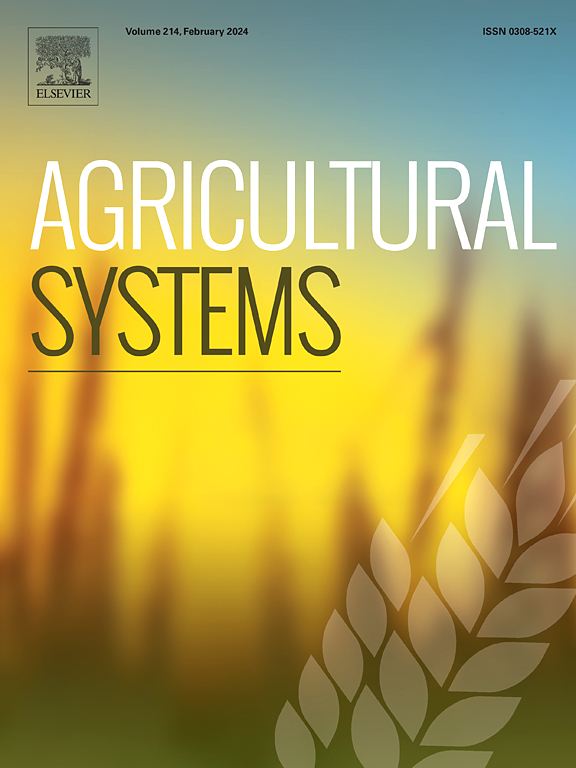Exploration of the optimal low-carbon peanut rotation system in South China
IF 6.1
1区 农林科学
Q1 AGRICULTURE, MULTIDISCIPLINARY
引用次数: 0
Abstract
CONTEXT
Peanut is an important economic and oil crop that has the potential to contribute to low-carbon agriculture. However, there is scarcity of comprehensive evaluations regarding the impact of various peanut rotation systems and their contribution to low-carbon agriculture.
OBJECTIVE
The research aims to comprehensively evaluate the contribution of peanut rotation systems to low-carbon agriculture in South China, and expected to explore the optimal low-carbon peanut rotation system in this area.
METHODS
Three cropping patterns were compared over a four-year experimental period: wheat–peanut (W-P) rotation, rape–peanut (R-P) rotation, and peanut monocropping (MP), under two types of initial fields (paddy and dryland). The carbon footprint (CF), product carbon footprint (PCF), carbon sequestration, food carbon cost (FCC), soil carbon characteristics, net economic benefit, and ecosystem service values of C sequestration of three rotation ecosystems were studied.
RESULTS AND CONCLUSIONS
Our findings reveal that R-P, W![]() P, and MP had total CFs of 1.788, 3.882, and 1.096 t CO2-eq·hm−2, respectively. Agricultural material input, particularly N fertilizer, was the primary CF contributor. R-P had higher carbon sequestration amount and efficiency than W
P, and MP had total CFs of 1.788, 3.882, and 1.096 t CO2-eq·hm−2, respectively. Agricultural material input, particularly N fertilizer, was the primary CF contributor. R-P had higher carbon sequestration amount and efficiency than W![]() P. Notably, dryland-initial fields of both R-P and W
P. Notably, dryland-initial fields of both R-P and W![]() P had higher carbon sequestration efficiency (71.1 % and 17.6 % higher, specifically). Our soil carbon analysis indicates that both plant residue quality and initial field type influence C sequestration. While W
P had higher carbon sequestration efficiency (71.1 % and 17.6 % higher, specifically). Our soil carbon analysis indicates that both plant residue quality and initial field type influence C sequestration. While W![]() P had the highest PCF (0.552 t CO2-eq t−1) and FCC of protein (3.428 kg CO2-eq·kg−1), fat (3.791 kg CO2-eq·kg−1), and energy (0.135 kg CO2-eq·1000 kcal−1), R-P showed the highest net income (3333.3 US$·hm−2) and higher ecosystem service value of C sequestration (−5.6 US$·hm−2). Furthermore, our findings reveal that common crop rotations in South China have higher CFs than the tested peanut-based systems. Therefore, R-P rotation is the most suitable system for low-carbon agriculture in the research area among these three rotations due to its lower carbon cost and higher economic benefits. And the advantages, disadvantages and uncertainties of different low-carbon agricultural indicators have also been analyzed.
P had the highest PCF (0.552 t CO2-eq t−1) and FCC of protein (3.428 kg CO2-eq·kg−1), fat (3.791 kg CO2-eq·kg−1), and energy (0.135 kg CO2-eq·1000 kcal−1), R-P showed the highest net income (3333.3 US$·hm−2) and higher ecosystem service value of C sequestration (−5.6 US$·hm−2). Furthermore, our findings reveal that common crop rotations in South China have higher CFs than the tested peanut-based systems. Therefore, R-P rotation is the most suitable system for low-carbon agriculture in the research area among these three rotations due to its lower carbon cost and higher economic benefits. And the advantages, disadvantages and uncertainties of different low-carbon agricultural indicators have also been analyzed.
SIGNIFICANCE
Our study would contribute to exploring agroecosystems management ways and methods to mitigation climate change and provide references for the establishment of evaluation criteria for low-carbon agriculture.

华南地区低碳花生最佳轮作制度探索
摘要花生是一种重要的经济作物和油料作物,具有促进低碳农业的潜力。本研究旨在全面评估花生轮作制度对华南地区低碳农业的贡献,并探索该地区最佳的低碳花生轮作制度。方法在四年的试验期内,比较了三种种植模式:小麦-花生轮作(W-P)、油菜-花生轮作(R-P)和花生单作(MP)。研究了三种轮作生态系统的碳足迹(CF)、产品碳足迹(PCF)、固碳量、食物碳成本(FCC)、土壤碳特征、净经济效益以及固碳的生态系统服务价值。结果与结论我们的研究结果表明,R-P、WP 和 MP 的总碳足迹分别为 1.788、3.882 和 1.096 t CO2-eq-hm-2。农业材料投入,尤其是氮肥,是造成碳吸收的主要因素。R-P 的固碳量和固碳效率均高于 WP。值得注意的是,使用 R-P 和 WP 的旱地初始田块固碳效率更高(分别高出 71.1% 和 17.6%)。我们的土壤碳分析表明,植物残留物质量和初始田块类型都会影响固碳效率。虽然 WP 的 PCF(0.552 吨二氧化碳当量吨-1)和蛋白质(3.428 千克二氧化碳当量千克-1)、脂肪(3.791 千克二氧化碳当量千克-1)和能量(0.135 千克二氧化碳当量千卡-1)的 FCC 最高,但 R-P 的净收入(3333.3 美元-hm-2)和固碳的生态系统服务价值(-5.6 美元-hm-2)最高。此外,我们的研究结果表明,华南地区常见的轮作方式比以花生为基础的试验系统具有更高的固碳量。因此,在这三种轮作中,R-P 轮作因其较低的碳成本和较高的经济效益而成为最适合研究区低碳农业的轮作体系。本研究将有助于探索减缓气候变化的农业生态系统管理途径和方法,为建立低碳农业评价标准提供参考。
本文章由计算机程序翻译,如有差异,请以英文原文为准。
求助全文
约1分钟内获得全文
求助全文
来源期刊

Agricultural Systems
农林科学-农业综合
CiteScore
13.30
自引率
7.60%
发文量
174
审稿时长
30 days
期刊介绍:
Agricultural Systems is an international journal that deals with interactions - among the components of agricultural systems, among hierarchical levels of agricultural systems, between agricultural and other land use systems, and between agricultural systems and their natural, social and economic environments.
The scope includes the development and application of systems analysis methodologies in the following areas:
Systems approaches in the sustainable intensification of agriculture; pathways for sustainable intensification; crop-livestock integration; farm-level resource allocation; quantification of benefits and trade-offs at farm to landscape levels; integrative, participatory and dynamic modelling approaches for qualitative and quantitative assessments of agricultural systems and decision making;
The interactions between agricultural and non-agricultural landscapes; the multiple services of agricultural systems; food security and the environment;
Global change and adaptation science; transformational adaptations as driven by changes in climate, policy, values and attitudes influencing the design of farming systems;
Development and application of farming systems design tools and methods for impact, scenario and case study analysis; managing the complexities of dynamic agricultural systems; innovation systems and multi stakeholder arrangements that support or promote change and (or) inform policy decisions.
 求助内容:
求助内容: 应助结果提醒方式:
应助结果提醒方式:


